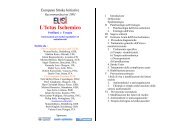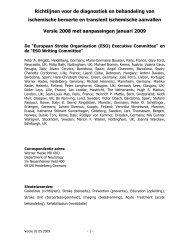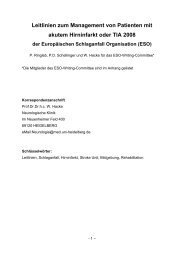Guidelines for Management of Ischaemic Stroke 2008 - ESO
Guidelines for Management of Ischaemic Stroke 2008 - ESO
Guidelines for Management of Ischaemic Stroke 2008 - ESO
Create successful ePaper yourself
Turn your PDF publications into a flip-book with our unique Google optimized e-Paper software.
<strong>ESO</strong>-<strong>Guidelines</strong> <strong>for</strong> <strong>Management</strong> <strong>of</strong> <strong>Ischaemic</strong> <strong>Stroke</strong> <strong>2008</strong><br />
Pulmonary function and airway protection<br />
Normal respiratory function with adequate blood oxygenation is believed to be<br />
important in the acute stroke period to preserve ischaemic brain tissue. However,<br />
there is no convincing evidence that routine provision <strong>of</strong> oxygen at low flow rates to<br />
all acute stroke patients is effective [359]. Identification and treatment <strong>of</strong> hypoxia is<br />
believed to be important in individuals with extensive brain stem or hemispheric<br />
stroke, seizure activity, or complications such as pneumonia, cardiac failure,<br />
pulmonary embolism, or exacerbation <strong>of</strong> COPD. Blood oxygenation is usually<br />
improved by the administration <strong>of</strong> 2-4 litres <strong>of</strong> oxygen via a nasal tube. Ventilation<br />
may be necessary in patients with severely compromised respiratory function.<br />
However, be<strong>for</strong>e ventilation is per<strong>for</strong>med the general prognosis, coexisting medical<br />
conditions, and the presumed wishes <strong>of</strong> the patient need to be considered.<br />
Cardiac care<br />
Cardiac arrhythmias, particularly AF, are relatively common after stroke, and heart<br />
failure, myocardial infarction and sudden death are also recognized complications<br />
[360, 361]. A significant minority <strong>of</strong> stroke patients show raised blood troponin levels<br />
indicative <strong>of</strong> cardiac damage [362]. Every stroke patient should have an initial ECG.<br />
Cardiac monitoring should be conducted to screen <strong>for</strong> AF. Optimizing cardiac output<br />
with maintenance <strong>of</strong> high normal blood pressure and a normal heart rate is a<br />
standard component <strong>of</strong> stroke management. The use <strong>of</strong> inotropic agents is not<br />
routine practice, but fluid replacement therapy is commonly used to correct<br />
hypovolaemia. Increases in cardiac output may increase cerebral perfusion.<br />
Restoration <strong>of</strong> normal cardiac rhythm using drugs, cardioversion or pacemaker<br />
support may occasionally be required.<br />
Fluid replacement therapy<br />
Many stroke patients are dehydrated on admission to hospital, and this is associated<br />
with a poor outcome [363]. Although clinical trial evidence is limited, delivery <strong>of</strong><br />
intravenous fluids is commonly considered part <strong>of</strong> general management <strong>of</strong> acute<br />
stroke, particularly in patients at risk <strong>of</strong> dehydration due to reduced consciousness or<br />
impaired swallowing. Experience in the management <strong>of</strong> hyperglycaemia supports the<br />
avoidance <strong>of</strong> dextrose in the early post-stroke phase [364]. More specialist fluid<br />
- 50 -





